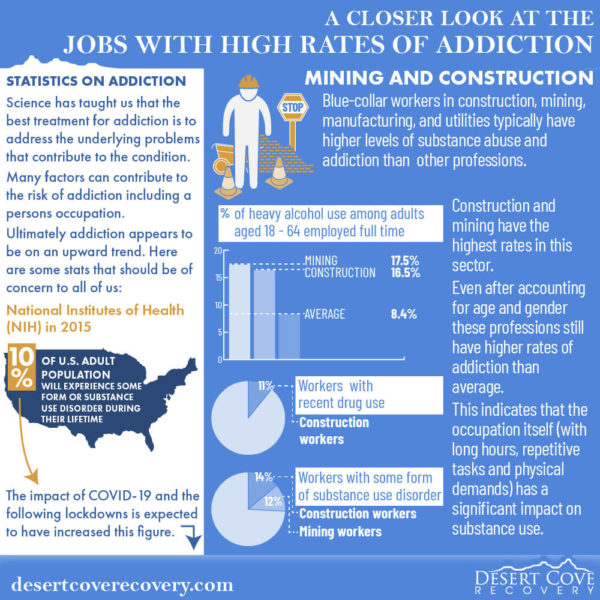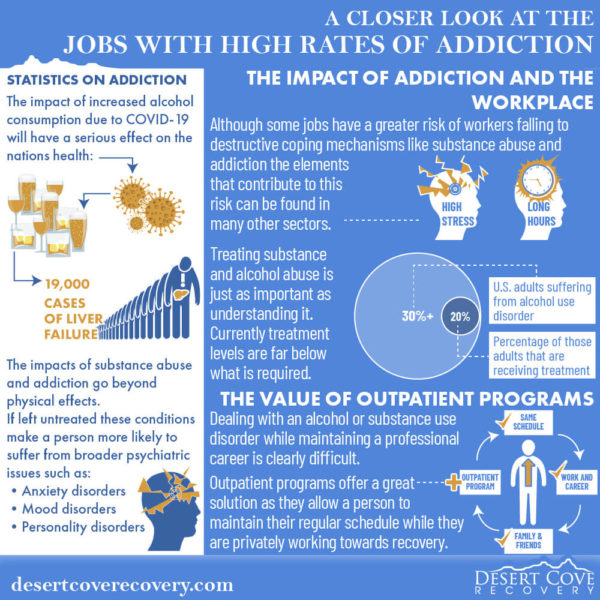As the science around addiction grows, we are beginning to learn that several factors affect one’s likelihood of becoming addicted. There is a genetic predisposition, of course, but there are also many other essential factors, such as possible trauma, destructive behaviors, or working at one of the jobs with the highest rates of addiction, that can also significantly affect one’s chances to become addicted.
At Desert Cove Recovery, we understand that to treat addiction; you need to be able to address all of its underlying causes. Addressing the causes begins with education and understanding. To that end, we’ll focus on one of the critical external factors that may lead to addiction: the role that certain stressful and demanding professions may play.
By the end of this piece, you should have a much better understanding of the role a job may play in causing addictive tendencies and which jobs have the highest rate of addiction.
Continued after video:
Addiction is a Growing Problem
Before we dive too deeply into individual professions, we need to understand that the last significant study done by the National Institutes of Health (NIH) looking at drug abuse and addiction was all the way back in 2015. But even then, it was apparent we were trending in the wrong direction with addiction treatment as a country.1 It was estimated in 2015 that over ten percent of the U.S. adult population would experience some form of drug use disorder in their lives. Following recent events of the Covid-19 pandemic, this number has almost assuredly grown significantly larger.
- A study done in the Spring of 2021 study found almost a third of Americans had increased their alcohol consumption after the COVID-19 pandemic began and almost 30% of drug users have increased drug usage in that period.2
- Marijuana and hallucinogen use among young adults reached an all-time high in 2021.3
We have seen the reported rates of alcohol usage among young adults grow from 1.2 million people in 2002 to 2.4 million people in 2019. In 2020, when Covid-19 hit and lockdowns began, these rates are thought to have skyrocketed even further. Right now, we may very well be in the middle of one of the biggest drug and alcohol addiction crises ever to face the country.
The increase in alcohol consumption during COVID-19 alone is expected to cause at least 19,000 cases of liver failure and a steep growth in the cases of liver cancer.4
The ramifications of alcohol and drug abuse disorders go well beyond substance abuse alone. Those with untreated drug use disorders were at much greater risk for broader psychiatric issues such as anxiety, mood, and personality disorders.
Work Cultures and the Various Root Causes of Addiction
Finding the roots causes of addiction can be difficult as everyone walks a different road through life; however, it is vital for society as a whole to begin to find the correlations between addiction and one’s lifestyle and occupation.
For many, the stress and pressure of work have been shown to be a major catalyst in their adoption of harmful coping mechanisms, which regularly turn to addiction.
By understanding the daily stresses and struggles that one is going through, organizations like ours can better create holistic methods that both include the 12-Steps and other practices chosen based upon the needs of the individual. This information may also help certain individuals recognize their own daily struggles and whether or not their job may be pushing them toward, or reinforcing, an addiction.
5 Jobs with the Highest Rates of Addiction and Substance Abuse
The following are the jobs with the highest rates of illicit drug use, alcohol abuse, and addiction.
Rates of Addiction in Mining and Construction Jobs
The addiction rate amongst blue-collar workers in construction, mining, manufacturing, and utilities is typically much higher than the rates found in many other professions. Specifically, in the construction and mining fields, the rate of alcohol abuse is almost double that of the national average. Over 11% of workers in construction admitted to recent drug usage in construction.5
14% of construction workers reported some form of substance use disorder, while nearly 12% of mining workers had similar issues. These are amongst the highest rates of any profession.5
It is worth noting that when they dove into the numbers around construction and controlled for gender and age, they still found construction workers struggling with addiction at higher rates than the average American, indicating that the job itself plays a significant role in creating the high rates of illicit drug use and alcohol abuse.
These are demanding jobs, and it is easy to see how the hard work, long hours, and repetitive tasks can take a toll on an individual and their psyche and often leads to a “work hard, play hard” mentality.
Hospitality and Foodservice Professionals
Almost ten percent of all workers in the United States fall under the umbrella of the hospitality and food service industry. This can refer to a wide range of jobs, including hotel managers, event organizers, chefs, and waiters (as well as countless other roles).
This fast-moving and high-stress industry requires long hours and constant mental strain. In fact, many in these industries spend considerably more time at work than they do at home. With alcohol already on hand in these locations and anxiety running high, this profession is seemingly designed to create addiction, with some of the highest rates in the nation.
In a NSDUH survey done in 2020, almost one in five respondents reported using drugs like marijuana, opioids, and cocaine as a coping mechanism. Nearly 17% have already been diagnosed with a substance use disorder. Just under 12% reported ‘heavy’ alcohol usage. 6
This is not just a result of Covid either. Scientific observations regarding the correlation between substance abuse and hospitality professionals go back to 1994 when the Addiction journal noted the much higher rates of alcohol abuse in the restaurant and hotel industries. 7
Managers and Supervisors
This is a broad term and overlaps with our previous fields. Restaurant managers, for example, have some of the highest rates of alcohol abuse in the country. Most managers and supervisors are forced to work under great pressure regularly. These individuals are often responsible for the work quality and livelihoods of several employees and ultimately responsible for their teams meeting deadlines and customer expectations.
Regardless of the field in which they specialize, 12% of management professionals surveyed in the 2015 SAMHSA report had used illegal drugs in the previous month, and over 11% reported some form of substance abuse disorder that year. 5
In order to help themselves manage these long hours and regular stresses, managers and supervisors will often turn to stimulants like cocaine or Adderall. The abuse of opioids and prescription painkillers is also prevalent in this demographic.
Artists, Actors, and Other Entertainment Industry Professionals
Continuing our list of jobs with the highest addiction rates, we come to the artists and creatives. The specter of substance abuse has long hounded the creative professions. This is such a common theme amongst artists that all Paris exhibits have been dedicated to the topic. The deep and intertwining links between creativity, mental trauma, and addiction are not well understood, but they are very evident to those who study such things.
While much attention is paid to those addicted artists who burned bright before having their flames extinguished by an early grave, it is worth understanding that thousands of struggling creators are suffering today with addiction, alone and unremarked.
In the SAMHSA report, 14% of those in the entertainment industry had participated in some form of illicit drug use in the past month, and over 11% have participated in some form of excessive alcohol consumption.
The entertainment industry is more than struggling artists, though, and can pertain to everyone from the craft service provider to a set painter. However, even in those roles, addiction rates are above average. One theory is that substance abuse is promoted by the odd working hours and cultural pressures that come with such jobs.
Telecommunications, Tech, and Broadcasting Rates of Addiction
This is another broad category that is related to the platforms that distribute or manage communications and information. This field can include lawyers, engineers, coders, and many others with highly specialized skill sets and advanced degrees.
Amongst these workers, the alcohol abuse rate is lower than some of the other professions, with about 8% of information industry workers reporting relying on heavy drinking regularly. However, rates of illicit drug use in this sector are much higher at nearly 12%. 5
Perhaps the most alarming statistic is that roughly one in five tech professionals abuse opioids like OxyContin, Vicodin, Xanax, and others.9
The drug abuse in tech likely stems from the stress and anxiety created by the weight of their job, as well as the act that they are often required to work alone or in small teams for long undefined hours. The stress can quickly build up when you never fully leave work and are always at a computer.
The Impact of Addiction and the Workplace
This article was just a small example of certain professions whose correlation with substance abuse has been relatively well documented. However, you should keep in mind that all of these same factors, such as long hours and constant stress, can easily be found in any industry and can quickly lead to destructive coping mechanisms and addiction if left to rot.
As we struggle with this addiction epidemic, greater efforts must be made to figure out the root cause of these issues and to get care to the individuals who need it most. The same NIH study we quoted throughout this article also found that most with a drug use disorder never receive treatment. The same issue arises with alcohol as almost a third of U.S. adults today suffer from alcohol use disorders or will at some point in their lives. Less than twenty percent of those with alcohol use disorders will receive care. 8
Outpatient Programs Give Workers More Options
Staying on course in your profession while seeking recovery from addiction can be incredibly challenging. These challenges are why quality outpatient programs provide the best option for employees who need help. Good outpatient programs allow you to keep your regular schedule, so nobody needs to know that you are working towards addiction recovery.
As a working professional utilizing Desert Cove recovery outpatient services, you’ll be able to keep up with your career and take care of yourself, your body, and your mental health.
At Desert Cove Recovery, we have designed an outpatient program that can work with various jobs and careers and can accommodate almost any schedule. We are quickly becoming one of Arizona’s premier drug, alcohol, and dual diagnosis treatment centers with a staff of caring and highly educated professionals. Contact us today and start your journey to overcome addiction.
Sources:
[1] NIH News Release: 10 percent of US adults have drug use disorder at some point in their lives | https://www.nih.gov/news-events/news-releases/10-percent-us-adults-have-drug-use-disorder-some-point-their-lives [2] The Mental Health Index™ Report: May 2021 | https://lifeworks.com/en/resource/mental-health-index%E2%84%A2-report-may-2021 [3] HIH News Release: Marijuana and hallucinogen use among young adults reached all time-high in 2021 | https://nida.nih.gov/news-events/news-releases/2022/08/marijuana-and-hallucinogen-use-among-young-adults-reached-all-time-high-in-2021 [4] Harvard Gazette: Study holds warning on pandemic drinking | https://news.harvard.edu/gazette/story/2022/01/covid-related-drinking-linked-to-rise-in-liver-disease/ [5] SAMHSA: SUBSTANCE USE AND SUBSTANCE USE DISORDER BY INDUSTRY | https://www.samhsa.gov/data/sites/default/files/report_1959/ShortReport-1959.html [6] SAMHSA: Key Substance Use and Mental Health Indicators in the United States | https://www.samhsa.gov/data/sites/default/files/reports/rpt35325/NSDUHFFRPDFWHTMLFiles2020/2020NSDUHFFR1PDFW102121.pdf [7] NIH: Addiction . 1994 : Alcohol use in the service industry | https://pubmed.ncbi.nlm.nih.gov/8069174/ [8] SAMHSA: TRENDS IN SUBSTANCE USE DISORDERS AMONG ADULTS AGED 18 OR OLDER | https://www.samhsa.gov/data/sites/default/files/report_2790/ShortReport-2790.html [9] AAC: Is Your Profession More Likely to Struggle With Drug Abuse? | https://detox.net/uncover/drugs-in-the-workplace-industry-comparison/ [10] Under the Influence Tracing a Long Twisted History of Artists and their Drugs | https://worldcrunch.com/culture-society/under-the-influence-tracing-a-long-twisted-history-of-artists-and-their-drugs






